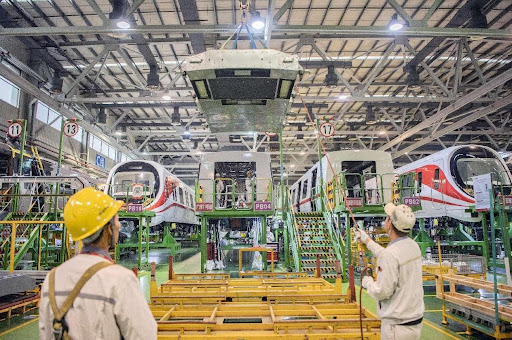By Li Xinping, People’s Daily
High-speed trains have greatly facilitated the transport for the Chinese people.
To produce a Fuxing high-speed train, it takes joint efforts from more than 2,100 enterprises.
The over 40,000 components needed to assemble a set of bullet trains are produced by suppliers from some 20 provinces, which forms a complex web of interdependent businesses.
China Railway Rolling Stock Corporation (CRRC) is the “locomotive” leading China’s rail transit industrial chain, which covers high-speed trains, as well as light rail and subway products. The company drives the integrated development of over 6,000 small- and medium-sized enterprises in upstream and downstream sectors. This has resulted in the formation of distinctive rail transit industrial clusters in places such as Hunan province’s Zhuzhou and Sichuan province’s Chengdu.
China’s high-speed train has amazing stability. Even a coin can be balanced on its edge on a moving bullet train.
Such high performance relies heavily on the crucial role played by shock absorbers. After nearly 10 years of joint efforts, CRRC and Zhuzhou Lince Group Co., Ltd., one of the biggest manufacturers and suppliers of rail transit equipment parts in China, have finally made a breakthrough in this field.
According to Qi Ran, deputy director of the supply chain management center at CRRC Zhuzhou Locomotive Co., Ltd., domestically produced shock absorbers are now among the best in the world.
CRRC chairman Sun Yongcai said that CRRC has extended its rich experiences in technological innovation as well as R&D management in urban rail transit equipment manufacturing to over 300 companies along the industrial chain, guiding them to improve their technologies, techniques and product quality. As a result, a group of companies with unique expertise and outstanding capabilities have emerged in their respective fields.
Rail transit is one of the most diverse categories in the equipment manufacturing industry, encompassing a rich industrial chain, value chain, and market chain. Zhuzhou is home to over 400 companies engaged in the sector, which makes it the world’s largest hub for the rail transit equipment manufacturing industry.
In this city, the time it takes to enjoy a cup of coffee is enough to produce over ten thousand components for an electric locomotive.
Zhuzhou is able to locally supply over 80 percent of the parts, components, and services needed by the rail transit equipment manufacturing industry, Qi said.
The advantage of industrial clustering not only deepens cooperation among companies along the industrial chain but also brings strong resilience to the entire industry, Qi added.
Last year, subway trains produced in China were put into operation in Türkiye. These trains were manufactured in Zhuzhou in just six months, much faster than the owner’s expectations.
In 2022, China’s first retro-style double-decker tourist tram exported to South Korea, also manufactured in Zhuzhou, achieved local production of all key components and was delivered in just four and a half months.
In Chengdu, rail transit industry clusters are also thriving, with 160 upstream and downstream companies settling in, achieving an industry aggregation rate of 60 percent.
On Shimu Road of the city, streams of trucks can always been seen transporting materials and equipment from the north side to the south side. On the south side, there is CRRC Chengdu Co., Ltd., while the north side is home to various supporting enterprises.
The clustering of supply and demand on both sides of the road facilitates rapid technological exchange, helping Chengdu’s rail transit industry transition from being scattered and small to becoming a strong whole. As a result, the city has emerged as the fifth-largest base for rail transit components in China.
By adhering to innovation and continuously striving for high-end and intelligent development, leading enterprises are driving supporting companies towards higher quality.
A Zhuzhou-based new material technology company has developed a “golden film” for trains – a high-performance polyimide film. This polyimide film is the world’s best-performing film insulation material. It can be applied in the manufacturing of not only rail transit equipment, but also crucial components in electronic products like smart phones and computers, as well as satellites and aircraft.
Thanks to the support from CRRC, this type of polyimide film is now massively produced in China and widely used in various fields such as offshore wind power generators and oil drilling motors.
In China, large, medium, and small enterprises are interdependent and mutually reinforcing, resulting in a series of exemplary cases of integrated innovation.
For instance, Syngenta Group, a provider of agricultural science and technology under Sinochem Holdings, has established a supply chain innovation center to conduct seed production research, driving technique innovation throughout the industry and reducing costs for seed suppliers in the industrial chain.
Additionally, Commercial Aircraft Corporation of China, Ltd. (COMAC) is exploring a model of integrated development for the entire composite materials industrial chain in large aircraft manufacturing. Leveraging platforms like the COMAC Innovation Valley, it brings together high-quality domestic and international aviation companies, as well as upstream and downstream supporting enterprises, to promote the translation of technologies and enhance collaboration.
The joint construction of projects, resource sharing, risk sharing, and benefit integration among large, medium, and small enterprises are effectively enhancing the resilience and security of China’s industrial chain and supply chain.




















